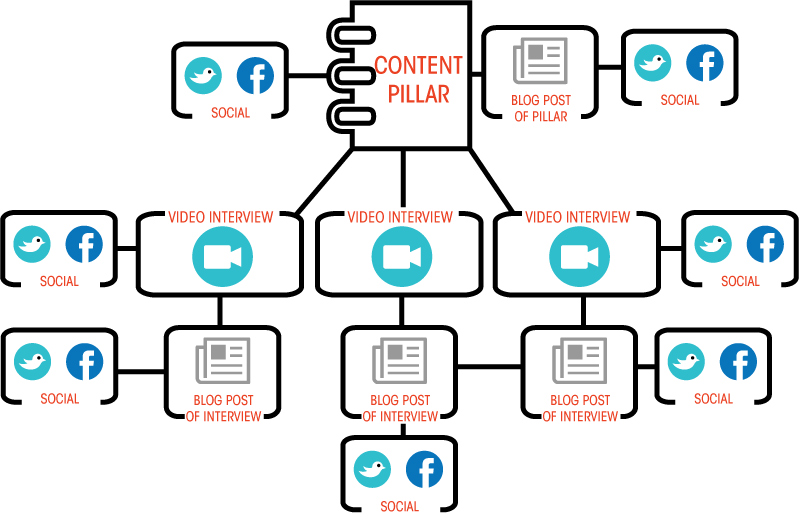So you want to increase page views and web traffic through content marketing?
It’s totally possible. We just did it.
This is the story of how one content campaign boosted our month-over-month site traffic by 84% (a 74% leap from our projected growth for the month).
Content Pillars Spike Web Traffic and Page Views
The story takes place in January 2014. Kapost analysts were projecting a 10% increase to January traffic over December. Still okay, but…
There was ammunition in the chamber.
Namely, we had yet to release an important content pillar called “Masters of SlideShare.”This SlideShare presentation highlighted advice from a few of SlideShares’ most successful contributors.
The campaign went live on January 27th. The impact was immediate (and huge). The first week Masters of SlideShare launched:
- We witnessed an 84% increase of unique visitors compared to our historical weekly average.
- Both referral and social traffic channels grew exponentially
- Unique visitors from referral traffic grew 142% compared to our historical weekly average
- Our direct channel traffic increased 94% compared to a historical week
And, it was our #1 socially shared piece of content ever with 1,962% increase over our average social shares.
“We witnessed an 84% increase of unique visitors compared to our historical weekly average.”
You might be thinking, well that must have just been one-heck-of-a-post. We can’t do that.
But you can. With a solid roll-out strategy, all content pillars can have a powerful, long-lasting impact.
How to Apply the Content Pillar Approach to Your Marketing
First, let’s make sure we all know what a content pillar is. A content pillar is a substantive and informative piece of content that supports a specific topic or theme that corresponds to your business expertise. It could be an eBook, a webinar, an infographic—anything, really, that is a significant, more thorough asset that holds a lot of weight.
Here are some examples of content pillars from other organizations:
- Marketo’s Definitive Guides
- Birchbox’s Women’s Magazine and Men’s Guide
- Content Marketing Institute’s Annual Content Marketing Benchmarks, Budgets, and Trends Report
Content pillars are incredibly valuable as a whole. But these huge assets can be a hard sell (they take a lot of time to consume). That’s where the smaller supporting assets make a big difference.

If you’re unfamiliar with this idea, this diagram illustrates how one content pillar can inform dozens of content pieces. A more comprehensive version of this diagram is available in the eBook, The Blueprint of a Modern Marketing Campaign. There, we walk you through how one content pillar can produce 269 content assets.
Break It Up!
A good content pillar campaign hits the right targets from many angles. You’ve got your main piece, but you also have an arsenal of supporting content assets that drive traffic to your pillar piece.
“A good content pillar campaign hits the right targets from many angles.”
The idea is that different people consume and process information in different ways. Communicating across multiple platforms and channels increases your chances of a successful launch.
“Think of all the spin-off stories you can create from your main message,” says Kapost’s Jesse Noyes, Senior Director of Content Marketing in his advice about how to transform a content pillar into a full-blown campaign.
That’s exactly what we did with the Masters of SlideShare.
In conjunction to publishing the SlideShare presentation, we also published:
- A blog post for each of the interviewees from the presentation, like this one with Doug Kessler.
- A separate deck that explains how we made our main piece.
- Several outbound emails including a call-to-action to view the presentation.
Share It, Send It, Push It, Buzz It
Give your content pillar the opportunity to succeed.
To do this, think of all the ways that you can share the asset: social media channels, emails, blogs, industry influencers, partner sites—wherever you can post your content. The more places you post, the wider your reach.
Then, coordinate your marketing team to implement the push. Everyone should know: Who is doing what? When does each piece go live? Is there an email campaign? Who’s in charge of social? What kind of tweets will go out? What are our goals with this content?
Update your team one week before the launch (include all outstanding items and who’s responsible for them), then again the day before launch (include sample social shares, links to the correct places, etc.).
Keep Tracking
The Masters of SlideShare stats were exciting (and blog-inspiring). But they aren’t the only metric needed to see the effectiveness of your content.
Page views and web traffic should be monitored over time to see how well the content asset proved over time; and ultimately you want to know how many leads or sales were generated through the immediate impact of your content. In other words, you connect with a lot of people, but have you connected with the right people?


